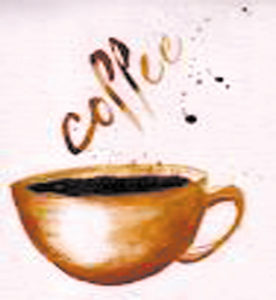 By Henry J. Pratt
By Henry J. Pratt Turkish citizens in the 13th century were among the first to enjoy roasted and ground coffee beans. Before that, cooks prepared coffee by boiling the fresh coffee beans in water.
The Turks considered coffee from roasted and ground beans so important that grooms, as part of marriage ceremonies, had to promise to keep their brides supplied with coffee makings. Dishonoring this pledge risked divorce, for coffee was considered a life necessity —not a luxury.
The old methods for roasting coffee failed to capture the full-bodied flavor needed to create a satisfying brew. Once American tinsmiths fashioned boxlike or cylindrical coffee roasters in the 1700s, coffee drinkers multiplied fast.
Cylindrical roasters with tight lids and long handles were placed by a hearth. The beans in them were moved around in the cylindrical head with great care, as the right amount of roasting time determined the best flavor. When coal stoves appeared, specially-made coffee bean roasters of a size to fit the stovetop openings housed roasting beans.
Once the coffee beans were roasted, they were ready for grinding. An early grinding method was to place the roasted beans in a mortar. Then, they were pounded with a pestle until the coffee was properly crushed. Early political and religious authorities argued whether coffee was a stimulant or an intoxicant. During the 1800s, some civil officials declared coffee was intoxicating, so they locked up the coffee houses. Some church leaders called the brew a drink of the infidel, and preached sermons about it.
Grinding coffee by mortar and pestle was later replaced by a coffee grinder or mill. The plate-iron coffee mill operated like a spice grinder, and that model ground coffee in the early 1700s.
At first, the ground coffee was caught in a dish, but by about 1750, a mill drawer was added to the grinder. Other grinders were made of steel or brass, often set on a wooden box having a drawer below.
The U.S. Patent Office was inundated with improvements and patents for home coffee mills in the 19th century. Improved table and wall models of cast iron and wood were introduced. Later came the popular wooden, boxlike grinder with a metal hopper cover.
Coffee drinkers in the Middle East continued to grow during the late 1500s. Regulations covering the brew relaxed and coffee could be sold and drank without penalty, provided such activities were out of public sight. Local governments levied and received substantial revenue from a luxury tax on coffee houses.
In 18th-century England, coffee grounds rivaled tea leaves for telling fortunes. Many believed fortunes and futures could be accurately foretold by looking at coffee grounds. Even today, Greek gypsies tell fortunes by reading patterns in coffee grounds. They will gladly pour you another cup of Joe, while reading the grounds left over from your first two cups. Take your pick in the 1990s: Get your fortune told by stargazers, tea leaves or coffee grounds!
By the year 1650, coffee was being roasted, ground, brewed and drank in most of Europe. But it wasn’t until about 1670 that coffee was introduced to North America.
Americans accepted coffee as a staple beverage only after tea became less popular following the Boston Tea Party of 1773. The colonies’ first coffee house was established in Boston in the late 1600s. The first silver coffeepot in the New World soon followed.
Straight-sided pots introduced in the early 1700s were supplanted by the single- and double-bellied pots widely advertised as the century progressed. Conical-shaped pewter coffeepots with a ribbed, domed lid became popular in the 1800s.
Today you can grind coffee beans in your own home in no time, and with little bother. Then, in one of scores of coffee pots and automatic makers in varying models and styles, you can brew fresh coffee fast. Many people say the extra aroma of freshly-ground Joe is well worth the effort to grind it yourself.
Editor’s Note: Joe is, of course, short for Joseph. And in American English, “joe” can refer to an average guy, a soldier, or — somewhat strangely — coffee. A popular chain in New York, for instance, is called Joe the Art of Coffee. As it turns out, the use of joe as slang for coffee dates to the World War I era.















Follow Us